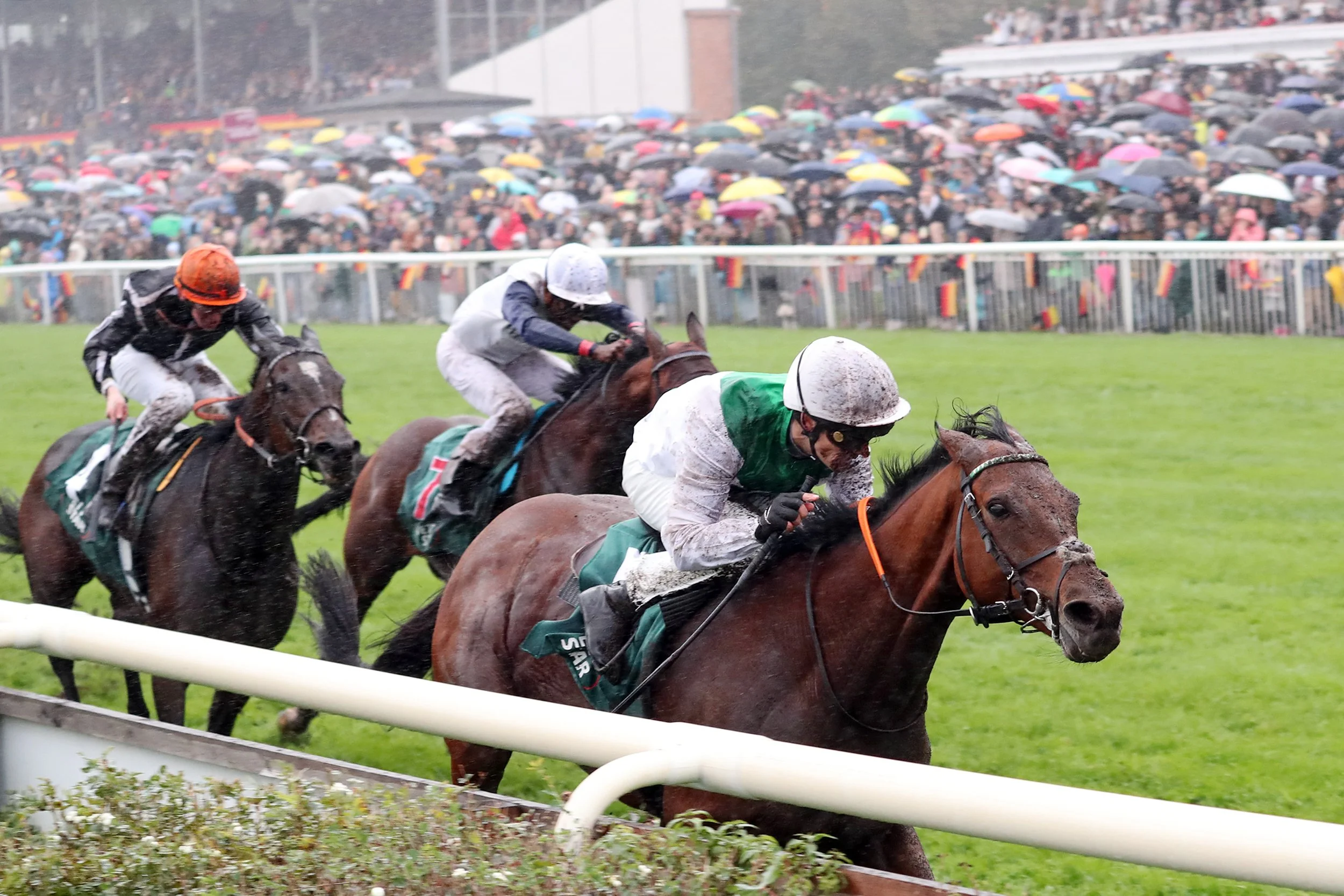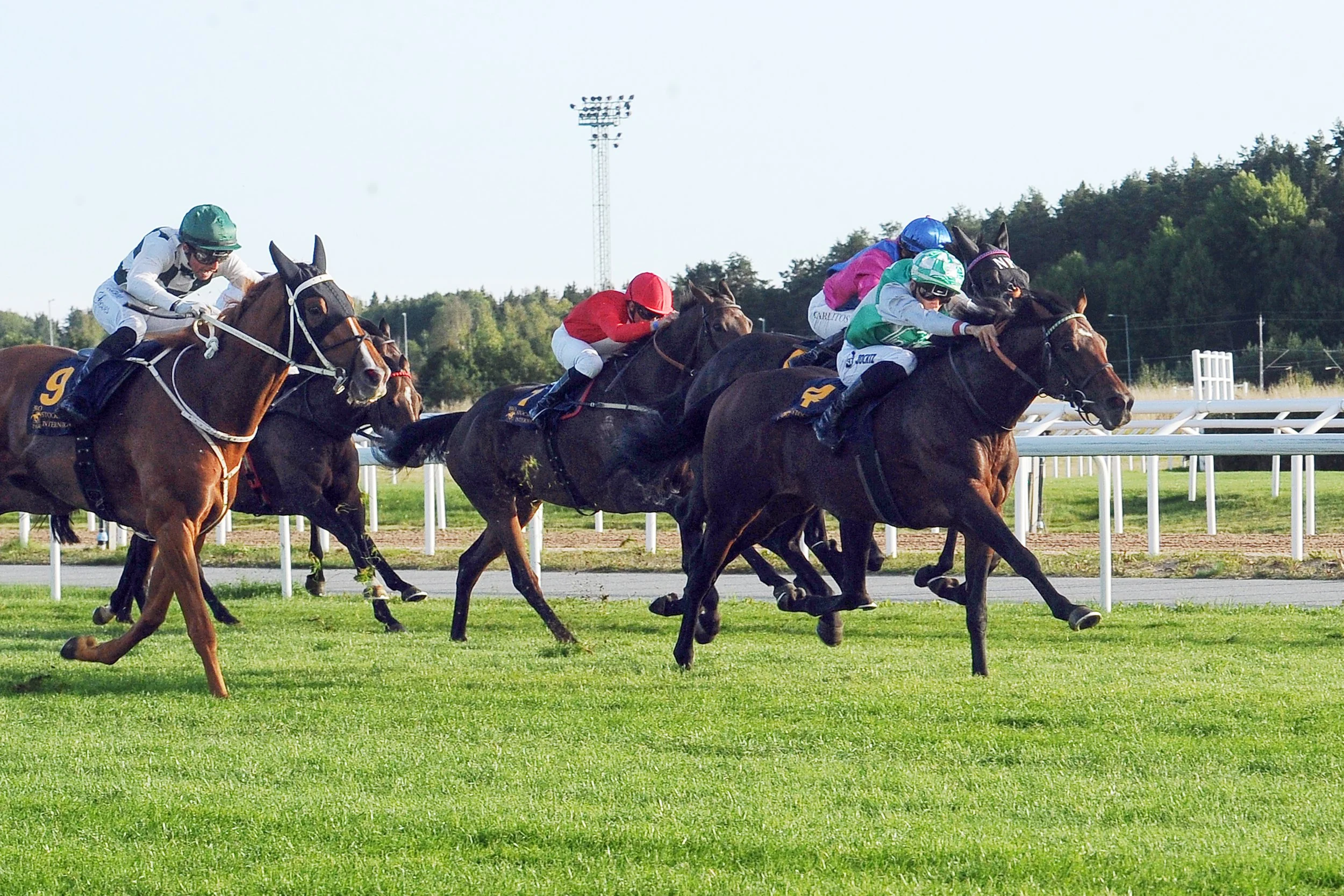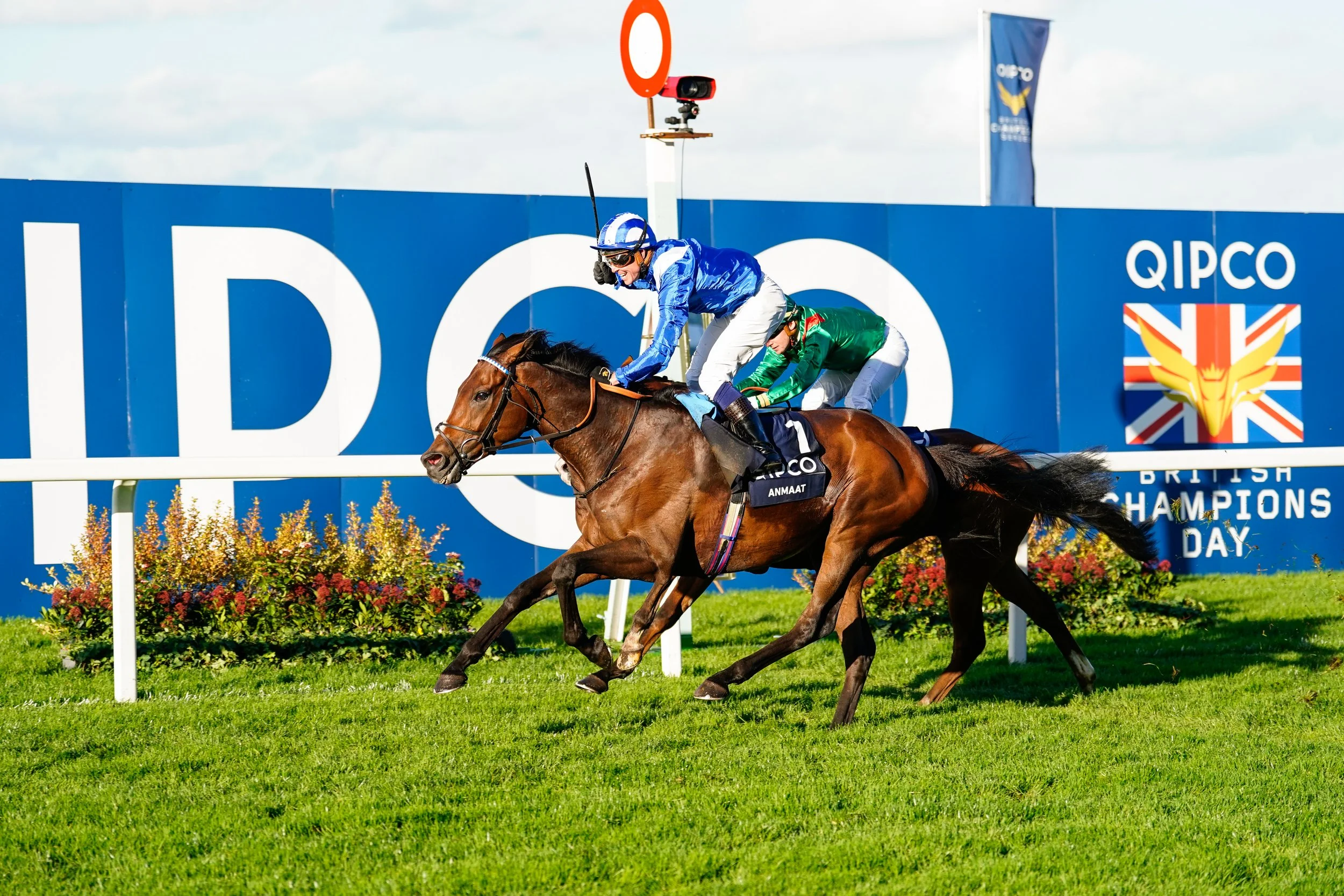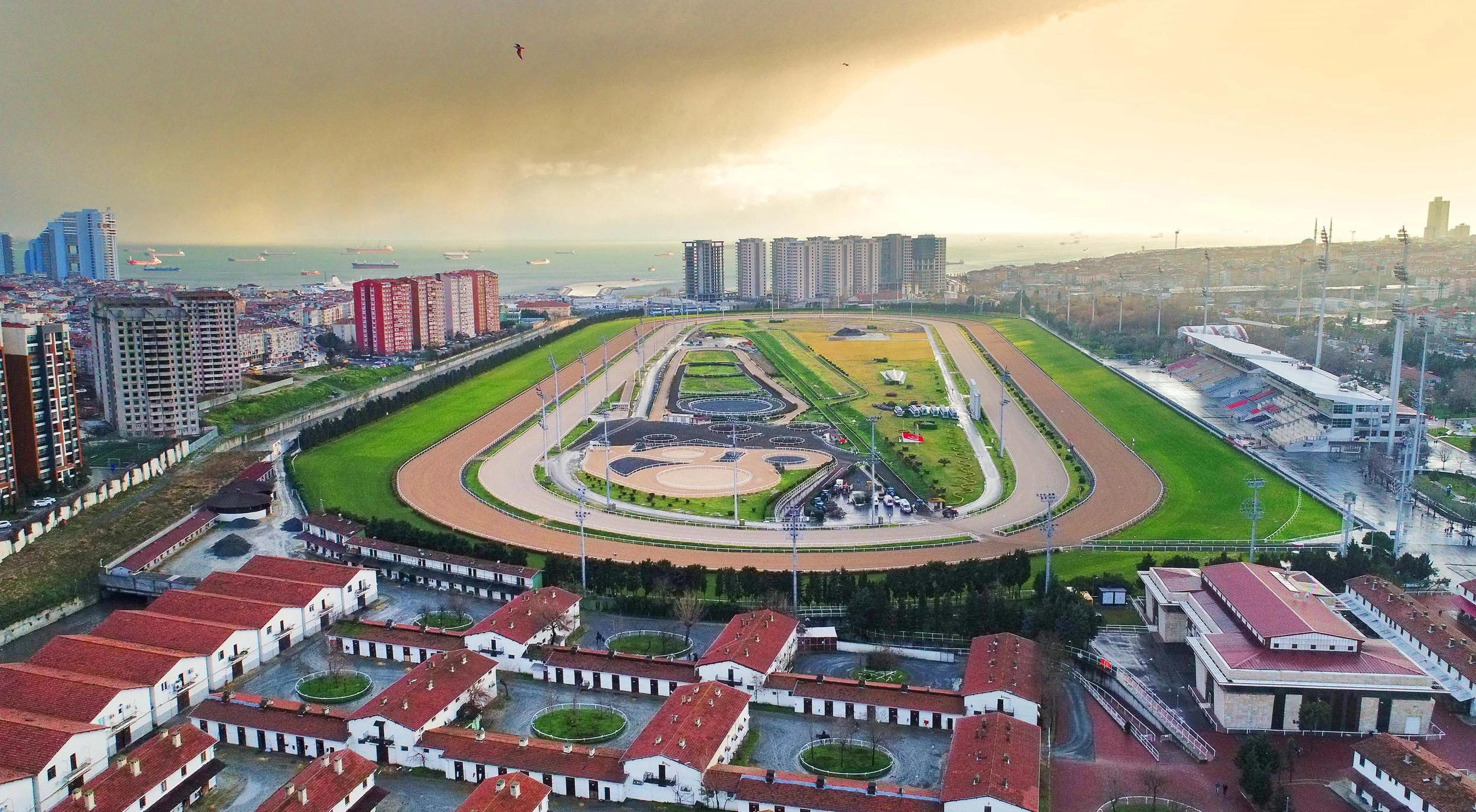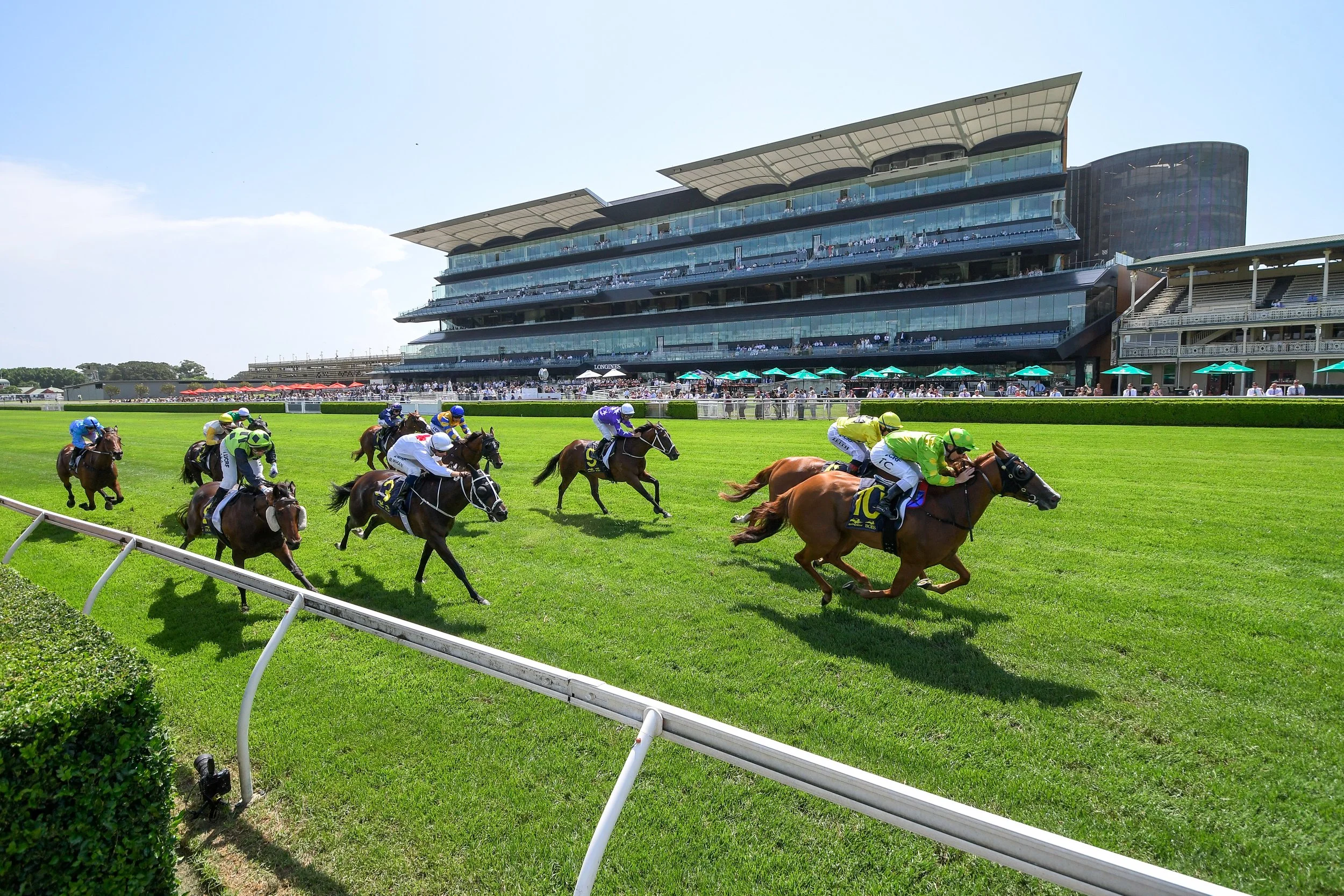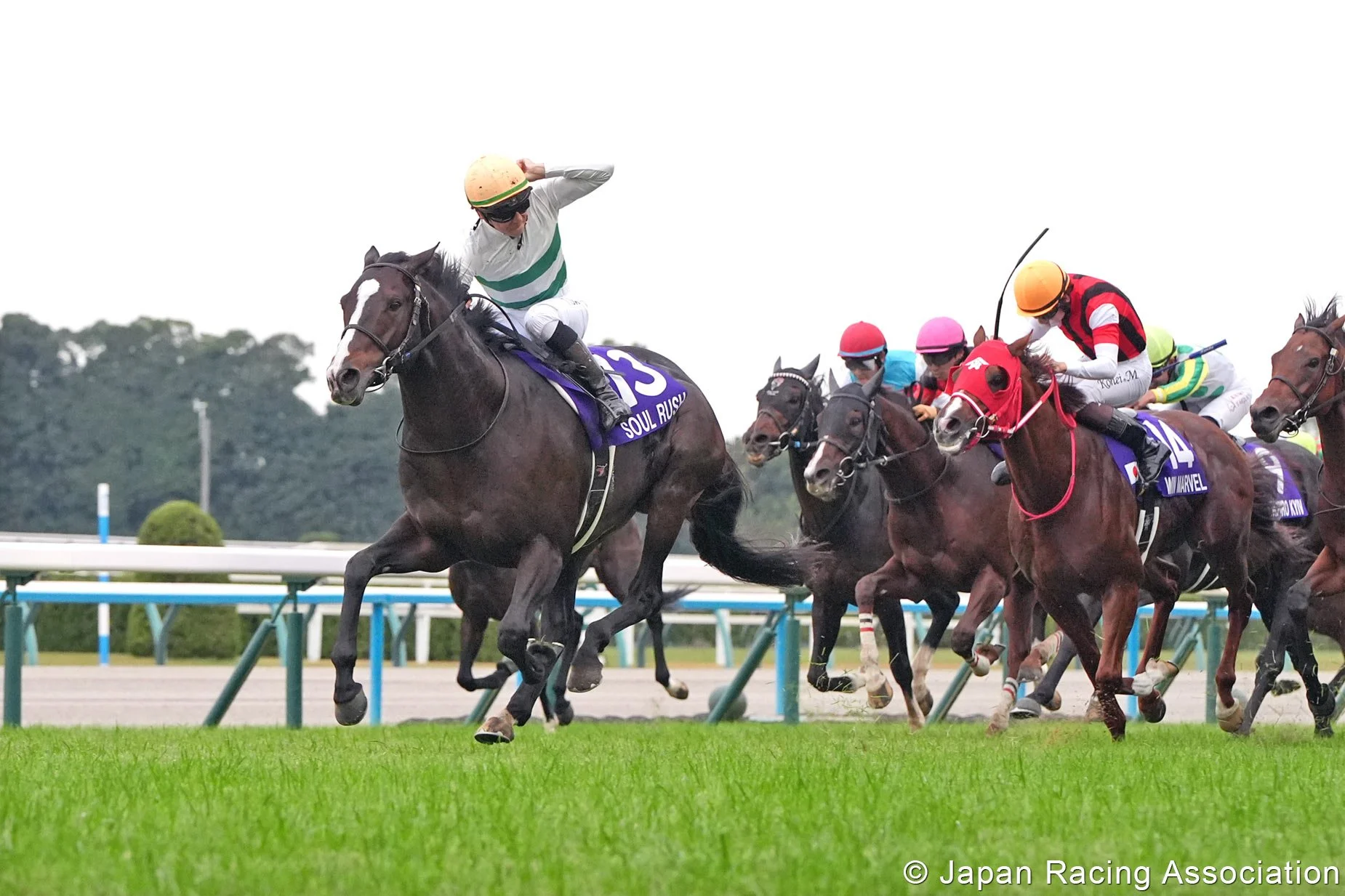Have Horse Will Travel - the international racing opportunities that trainers should be targeting this autumn
Ireland
The Irish Champions Festival takes place at Leopardstown and the Curragh 13th and 14th September respectively. The Curragh boasts the richest day of its year, with a card worth over €2.5m (£2.10m) in total. The highlights are the €600,000 (£503,865) Gp.1 Irish St Leger for three-year-olds and up, the Gp.1 Moyglare Stud Stakes and Gp.1 Vincent O’Brien National Stakes for juveniles and Gp.1 sprint The Flying Five Stakes, each worth €400,000 (£335,900).
The €200,000 (£168,000) Gp.2 Blandford Stakes, the €250,000 (£210,000) Tattersalls Ireland Super Auction Sale Stakes and two Premier Handicaps each worth €150,000 (£126,000) complete the card.
On the opening day at Leopardstown, the nine-race card features five Group races, including the €1.25m (£1.05m) Gp.1 Irish Champion Stakes 2000m (10f), the €400,000 (£335,900) Gp.1 Matron Stakes, €200,000 (£168,000) Gp.2 Solonaway Stakes, €150,000 (£126,000) Juvenile Stakes, €100,000 (£84,000) Gp.3 Tonybet Stakes, the €100,000 (£84,000) Ingabelle Stakes and two Premier Handicaps each carrying €150,000 (£126,000).
In addition to the Irish Champions Festival, the Autumn Racing Weekend will be held at the Curragh 27th and 28th September, which includes the 1400m (7f) €1m (£850,000) Goffs Million, the richest race for two-year-olds in Europe, and the richest handicap in Europe the 3200m (16f) Irish Cesarewitch, worth €500,000 (£425,000). The meeting will also include the Gp.2 Beresford Stakes (€120,000/£101,700) 1600m (8f) for juveniles, celebrating its 150th anniversary, 1200m (6f) Gp.3 Renaissance Stakes (€60,000/£50,800), and 1400m (7f) Gp.3 Weld Park Stakes (€60,000/£50,800).
Irish jumps series
For National Hunt runners, a series of seven 3300m (2m1f) 10-hurdle Irish Stallion Farms EBF Academy Hurdle races will be run in Ireland from October to December. The first is at Cork on 12th October, followed by Fairyhouse 4th October, Punchestown 13th November, Cork 23rd November, Navan 6th December, Naas 15th December and concluding at Leopardstown 29th December.
The races are open to three-year-olds which have not had any previous run under either Rules of Racing or I.N.H.S. Rules other than in Academy Hurdle races. Horses that run in any of the seven races can continue their careers in bumpers, maiden hurdles or Point-to-Points.
Jonathan Mullin, Director of Racing at HRI, explains, “Each of the races offer a Sales Voucher, similar to the IRE incentive for the owners of any eligible Irish-bred horse which wins or is placed either second or third. Each winning owner will receive a €5,000 voucher while the owners of the runner-up and the third-placed horses will each receive €3,000 and €2,000 respectively.”
Additionally, all seven races are part of the Weatherbys National Hunt Fillies Bonus Scheme, so three-year-old Irish-bred fillies that win an Irish EBF Academy Hurdle in 2025 will be awarded an additional €7,500 bonus on top of the race prize money and will still be eligible for the €5,000 scheme bonuses available if subsequently winning a bumper or a steeplechase, but not a maiden hurdle.
Germany
This season, Deutscher Galopp introduced 12 premium handicaps and 15 Premium Racedays, which included seven Group 1 racedays, guaranteeing at least €15,000 (£12,500) in handicaps and maiden races on those days.
The BBAG Auktionsrennen at Mülheim 4th October is worth €52,000 (£43,600), run over 2000m (10f) for three-year-olds offered as yearlings at the 2023 BBAG Sale, while at Krefeld 15th October is the €55,000 (£46,000) Gp.3 Herzog Von Ratibor-Rennen for two-year-olds, over 1700m (8.5f).
The Berlin-Hoppegarten card 3rd October is one of the Premium Racedays and as well as including the 2000m (10f) Gp.3 Preis Der Deutschen Einheit, €55,000 (£46,000) for three-year-olds and up, there is also a 1400m (7f) BBAG Auktionsrennen for three-year-olds offered as yearlings at the 2023 BBAG Sale, and a support card of seven other races from €15,000 (£12,500) to €22,000 (£18,500). Similarly, 19th October at Baden-Baden sees a nine-race card with the guaranteed minimum that also features the Gp.3 €155,000 (£130,000) Preis Der Winterkönigin for two-year-olds over 1600m (8f), and the Gp.3 Herbst Trophy €55,000 (£46,000) over 2400m (12f) for three-year-olds and up.
The 26th October Hannover Premium card includes the €55,000 (£46,000) Gp.3 Herbst-Stutenpreis over 2200m (11f) for three-year-olds and up and two €25,000 (£21,000) juvenile races over 2000m (10f) and, for fillies only, 1400m (7f). The Premium Racedays conclude at Munich 8th November, where the feature is the Gp.1 Grosser Allianz Preis Von Bayern over 2400m (12f) worth €155,000 (£130,000), and another €52,000 (£43,600) BBAG Auktionsrennen, this time for two-year-olds over 1600m (8f) offered as yearlings at the 2034 BBAG Sale.
Sweden
Sweden’s showcase takes place at Bro Park 12th September with a card that includes the Gp.3 Stockholm Cup International (Gp. 3) over 2400m (12f) for three-year-olds and up and worth SEK 1,000,000 (€91,700 / £76,900). The three Listed races on the support card are each worth SEK 550,000 (€50,500 / £42,350) and open to three-year-olds and up, namely the Bro Park Sprint Championship 1200m (6f), the Tattersalls Nickes Minneslöpning 1600m (8f) and the Lanwades Stud Stakes for fillies 1600m (8f).
Later Listed opportunities for three-year-olds up, each worth SEK 400,000 (€36,700 / £30,800), are the 2400m (12f) Skånska Fältrittklubbens Jubileumslöpning and the Peas and Carrots Mile over 1600m (8f) at Jägersro Galopp 5th October, and the 2100m (10.5f) Songline Classic at Bro Park 26th October.
Spain
The highlight of the Spanish season is Champions Day 19th October in Madrid, with a card that includes the Gran Premio Memorial Duque de Toledo over 2400m (12f) for three-year-olds and up, with a value of €50,000 (£42,000) and the Gran Premio Ruban over 1200m (6f) worth €40,000 (£33,500). The €40,000 (£33,500) Gran Criterium for two-year-olds is run over 1600m (8f) 26th October.
British Champions Day
Opening a card that features the British Champions Long Distance Cup (€590,000/£500,000), the British Champions Sprint Stakes ((€590,000/£500,000), the British Champions Fillies and Mares Stakes ((€590,000/£500,000), the Queen Elizabeth II Stakes (€1.36m/£1.15m), the Champion Stakes (€1.53m/£1.3m) and the 1600m (8f) Balmoral Handicap (€295,000/£250,000) is the newly-introduced Two-Year-Olds Conditions Race, worth €295,000 (£250,000), taking the total prize money on the day to €5.13m (£4.35m). Open to two-year-olds, the 1200m (6f) conditions race, like all races at this distance at Ascot, will be run over the straight course.
Turkey
The Jockey Club of Türkiye hosts seven international races in Istanbul at Veliefendi Racetrack, as part of the International Racing Festival run on the first weekend in September. The highlights are the €62,650 (£53,400) 2000m (10f) Gp.2 Anatolia Trophy for three-year-olds up, €190,000 (£162,000) Gp.2 1600m (8f) Topkapi Trophy for three-year-olds up, the €98,700 (£84,150) Gp.3 1200m (6f) Queen Elizabeth II Cup for two-year-olds, €197,500 (£168,400) Gp.3 2400m (12f) Bosphorus Cup for three-year-olds up and the Gp.3 1600m (8f) €142,400 (£121,400) Istanbul Trophy, entries closing 6th August. There is a transport subsidy for international races, $18,000 for round-trip per horse arriving from the continents of America (North and South), Oceania, Africa and Far East countries, €12,000 for round trip per horse arriving from Europe and United Arab Emirates. Any horses scratched from the race after arrival by veterinary report will still receive transportation subsidy. The Gp.3 Malazgirt Trophy for purebred Arabians over 1600m (8f) will also be part of the card.
USA
Kentucky Downs is home to America's only European-style 2000m (10f) all turf racecourse, hosting just seven days racing from 28th August to 10th September, entries closing from 16th August, when emailed expressions of interest must also have arrived for the invitationals. The feature races are the $3.5m (€3m/£2.6m) Gr.3 Nashville Derby Invitational over 2400m (12f) for three-year-olds, the $2.5m (€2.19m/£1.86m) Gr.3 1600m (8f) Mint Millions Invitational and the 2400m (12f) Gr.2 Kentucky Turf Cup Invitational of the same value which is also a "Win and You're In Breeders' Cup Turf" race. Both races are for three-year-olds and up.
Carrying $2m (€1.75m/£1.48m) each are the Gr.3 Kentucky Downs Ladies Turf for fillies and mares three-year-olds and up over 1600m (8f), the Gr.2 Kentucky Downs Ladies Turf Sprint 1200m (6f) for fillies and mares three-year-olds and up, the Gr.1 1200m (6f) Franklin-Simpson Stakes for three-year-olds, the Listed 1600m (8f) Gun Runner for three-year-olds, the Gr.2 1200m (6f) Music City Stakes for three-year-old fillies, the Gr.3 2000m (10f) Kentucky Downs Ladies Marathon Invitational for three-year-olds and up fillies and mares, the Gr.3 2000m (10f) Dueling Grounds Oaks Invitational three-year-old fillies, and the Gr.2 Kentucky Downs Turf Sprint 1200m (6f) for three-year-olds and up which is another of the "Win and You're In Breeders' Cup Turf Sprint Division” races.
Each carrying purses of $1m (€870,000/£738,000) are the Bowling Green Gold Cup Invitational 3200m (16f) for three-year-olds up, the 1600m (8f) Listed Kentucky Downs Juvenile Fillies, the 1200m (6f) Listed Kentucky Downs Juvenile Sprint, the 1600m (8f) Listed Kentucky Downs Juvenile Mile, and the 1200m (6f) Untapable Stakes for two-year-old fillies. The Listed Tapit Stakes over 1600m (8f) for three-year-olds up heads three races worth $500,000 (€437,000/£370,000), alongside the 1600m (8f) NTL Tight Spot Overnight Handicap for three-year-olds up, and the 1600m (8f) Listed One Dreamer for fillies and mares three-year-olds up. Maiden races, already the richest in the world, carry €181,000 (€158,000/£133,300) per race.
“We want to build the Nashville Derby into a race that American and European horsemen alike point to and buy horses for,” says Ron Winchell, co-managing partner of Kentucky Downs with Marc Falcone. “We’ve positioned the Nashville Derby so that it fits into a big-money circuit for three-year-old turf horses.”
The 42nd running of the Breeders’ Cup will be held for a fourth time in Del Mar, California, on the edge of the Pacific Ocean in San Diego “where the turf meets the surf”. Consisting of 14 Grade 1 races with purses and awards totalling more than $31m (€27.11m/£22.97m), the meeting takes place Friday 31 October and Saturday 1st November.
“Our return to Del Mar in back-to-back years marks the continuation of a wonderful collaboration and successful partnership, both with our friends at the track and with the greater San Diego area,” says Drew Fleming, President and CEO of Breeders’ Cup Limited. “We look forward to once again gathering where the turf meets the surf as the world’s best thoroughbreds put on an incredible show.”
“We couldn’t be more excited about hosting back-to-back Breeders’ Cup World Championships and welcoming the very best in international racing back to the town of Del Mar and the greater San Diego area,” said Joe Harper, CEO of the Del Mar Thoroughbred Club. “The Breeders’ Cup represents the pinnacle in world-class racing and the organisation’s willingness to return here again is a testament to the quality of our racing facilities, our idyllic weather, and the warm hospitality shown to our visitors by the local community.”
With 14 championship races held over two days, Future Stars Friday sees the two-year-old championships run for purses upwards of €931,130 (£783,500) and €1.9m (£1.6m). Saturday boasts nine races, culminating with the €6.5m (£5.5m) Gr1 Breeders’ Cup Classic. The “win and you’re in” series consists of 69 of the best races from around the world, from June to October, awarding each winner an automatic and free entry into the Breeders' Cup World Championships.
Bahrain
The Bahrain Turf Series is fairly new to the calendar and has seen just five renewals to date. Running from December through to February, each race carries prize money from €73,750 (£62,850) up to €91,880 (£78,200) with total and the series is designed to attract international runners rated 85-100 to compete against local Bahrain-based horses.
“We believe the time is right to build on the success of the Bahrain Turf Series and expand the international programme to incorporate our season’s premier races,” explains His Highness Shaikh Isa Bin Salman Bin Hamad Al Khalifa, Chairman of the Bahrain Turf Club. “Our most prestigious races, including the Crown Prince’s Cup and the King’s Cup, fall within the Bahrain Turf Series calendar, and are intended to make racing in Bahrain an even more attractive and compelling proposition for international visitors.”
In total, the Series of sprint and middle-distance races comprises of 12 races, six in each division, with each race carrying bonus prizes for the horses accumulating most points in their respective division.
At time of going to press the dates and 2025/26 prize monies were not available, but last year saw significant increases. In December are two 1000m (5f) and two 2000m (10f) races for horses rated 84-100 and a 1200m (6f) and 2000m (10f) race for those rated 80-100.
In January there are two conditions races, over 1000m (5f) and 1800m (9f). February, when the season concludes, sees opportunities for horses rated 80-100 at 1000m (5f), 1200m (6f), 1800m (9f) and 2000m (10f). For those seeking black type, the 2000m (10f) Gr2 Bahrain International Trophy in November for three-year-olds and up is establishing Bahrain as a premier horseracing destination. Run on turf, in 2024 the race was worth €921,858 (£785,315) in total, with €553,115 (£471,178) to the winner.
Entries close 2nd October with supplementary entry stages later in October, but there are three 'Automatic Invitation' races, for the first, second and third from The Royal Bahrain Irish Champions Stakes and the Gp.3 Strensall Stakes at York. The Bahrain Turf Club will provide air tickets for overseas connections and hotel accommodation on a room only basis. Shipment of invited horses will be arranged and paid for by the Bahrain Turf Club.
Australia
The Melbourne Cup Carnival needs no introduction and the Cup itself is only one of 10 Gp.1 racedays during the 22-day season at Flemington. The 3200m (16f) Gr1 Melbourne Cup will be worth A$8.66m (€4.93m / £4.14m) this year, with prize money down to 12th.
During the week there are three €1.8m (£1.6m) weight-for-age Gr1s, the 2000m (10f) Champion Stakes, 1600m (8f) Champions Mile and the 1200m (6f) Champions Sprint. “It is always a great thrill to host international connections who make the journey to Melbourne,” Leigh Jordon, the VRC Executive General Manager, tells us.
More recently the Sydney Everest Carnival held at Royal Randwick and Rosehill Gardens has competed for equal attention, running from 21st September to 9th November, and boasting the world’s richest race on turf, The Everest, over 1200m (6f) in mid-October at Royal Randwick and worth A$20m (€11.3m / £9.5m). The opening day at Royal Randwick features two weight-for-age races, each with a total prize of €615,840 (£520,265) for three-year-olds and up, The 7 Stakes 1600m (8f) and the Gp.2 1100m (5f) Shorts. Randwick later hosts the iconic 1600m (8f) Epsom Handicap, a Gp.1 worth €924,000 (£780,500) and on the Everest supporting card is the €3m (£2.6m) Gp.1 King Charles III Stakes over 1600m (8f).
At Rosehill Gardens, the Hill Stakes over 2000m (10f), and 1800m (9f) Five Diamonds each carry a purse of €1.2m (£1m), with the €6.2m (£5.2m) Golden Eagle over 1500m (7f) the showpiece in November.
Japan
The JRA offers travel incentives for particular overseas horses for Group 1 races and for invited overseas horses for the Japan Cup. The JRA provides air transport costs for the horse and two attendants, the owner, trainer, jockey, and their spouse/partner, and five nights’ accommodation at a JRA designated hotel.
All Japanese Gr.1s are free to enter, or by free invitation, and carry the same declaration fee of €20,200 (£17,500), with significant bonuses from first down to last for the participating winners of designated Gr.1 races globally. The 2400m (12f) Japan Cup is run at Tokyo in November for a purse of €7.3m (£6.3m), Also in November, at Kyoto, the 2200m (11f) Queen Elizabeth II Cup for fillies and mares carries a purse of €1.9m (£1.6m), and The Mile Championship is worth €2.7m (£2.3m). Run on dirt at Chukyo Racecourse, the 1800m (9f) Champions Cup has a total value of €1.7m (£1.5m).
2023 Champion Trainer profiles - Peter Schiergen (Germany) / Kadir Baltaci (Turkey) / Claudia Erni (Switzerland)
NATIONAL CHAMPION TRAINERS IN FOCUS
In this issue, we take a look at some more of Europe’s champion national trainers, courtesy of the latest data compiled by Dr Marian Surda, doyen of Slovakian racing.
A notable feature of the tables, when comparing the last two years, is the infrequency of trainers retaining their crowns. Only in 7 of the 18 countries that featured in both years did this happen (France, Jean-Claude Rouget; Ireland, Aidan O’Brien; Spain, Guillermo Arizkorreta; Germany, Peter Schiergen; Norway, Niels Petersen and Greece, Charalambos Charalambus). The baton changed in all other countries, including in Great Britain, the country whose trainer earned the most money, for the second year running. This time, that trainer was the father and son combination of John and Thady Gosden, who wrested the title from Charlie Appleby.
Among the jockeys, Maxim Guyon, in France and William Buick, in Britain headed the table once again. But the dominance of the big three countries – France, Britain and Ireland – was interrupted by an extraordinary performance by Turkey’s Champion, 20-year-old Vedat Abis, who clocked up a remarkable 283 wins – far more than any of his fellow champions.
Our featured trainers this year are Peter Schiergen (Germany / 5th in the table), Kadir Baltaci (Turkey / 6th) and Claudia Erni (Switzerland / 11th).
PETER SCHIERGEN
The name of Peter Schiergen is a familiar one across the European racing scene and beyond, with Group wins in France, Britain, Italy and Dubai as well as his native Germany. At time of writing, that Group race tally stands at 199. Champion Trainer in Germany no fewer than eight times (2002, 2005, 2006, 2013, 2015, 2021, 2022 and 2023), with six German Derby wins to his name (Boreal 2001, Schiaparelli 2006, Kamsin 2008, Lucky Speed 2013, Nutan 2015 and Sammarco 2022), his crowning single achievement remains his Arc win with Danedream in 2011.
But before becoming one of the most successful German trainers of recent generations, Peter had been one of his country’s most successful jockeys. His outstanding record in the saddle encompassed five jockeys’ championships – 1992 to 1996 – and nearly 1500 wins, including a record 271 successes in 1995.
I asked Peter about his journey into racing and what had led to his becoming a jockey at the age of 16. “I always wanted to become a show jumper. My plan was just to do my apprenticeship in racing and after that to go back to show jumping. But it turned out differently and I had quite a bit of success as an apprentice and stayed in the game”.
The transition from jockey to trainer (taking over from fellow legend Heinz Jentzsch in 1998) was made at a younger age – just 33 – than is often the case.
“The opportunity came up to take over from Heinz Jentsch. I knew that this was a huge chance and even though it was quite early I decided to take over. I started in 1998 in Köln and still train there today. In 2009 we built a new stable next to the old one so that’s really the main thing that has changed”.
“I had a great time as a jockey and was five consecutive years champion jockey and broke the European record in 1995. But the owners didn’t give me the chance to ride in the big races abroad such as Lando in the Japan Cup. This is something I don’t want to happen to my stable jockeys and therefore I use them both in Germany and abroad.
What does Schiergen consider the pros and cons of training on the track? “The horses are used to the racetrack. A great benefit is that it’s easier to get staff. Furthermore, the racecourse is in charge of preparing the training facilities. A disadvantage would be that we have certain times at which we must be at the track, as there are many trainers who use the facilities. On a private track you have more peace”.
“The team consists of 25 staff. It gets more and more difficult to get good staff and competent work riders. We have a great team and many people have been staff members for many years. There are plenty of Germans working with us. Other than Germans, most of the staff tend to be from the eastern European countries such as Poland, Czech Republic, Bulgaria etc.”.
When asked which trainer he admires the most, Schiergen replies: “I didn’t have a jockey I admired the most when I was a jockey, and now, as a trainer, neither do I have a trainer I would single out as admiring. I look at many others and try to take the best of each”.
“The state of racing in Germany isn’t great, but there are many ambitious people who are trying to bring the sport back to better times. It’s difficult with social change and especially the animal welfare movement. Racing’s lobby sometimes appears to be too weak to work against these forces. Therefore, we need a change. It’s difficult to compare our racing jurisdiction to other countries. We don’t have training facilities such as Newmarket or Chantilly.”
As well as the 200 Group race milestone, Schiergen has another in his sights. Ending last year on 1,907 wins on the flat and 31 over jumps, it is a real possibility that he could send out his 2,000th winner this year. “Certainly is a milestone and a great achievement. But it is more important to win big races.”
KADIR BALTACI
Kadir Baltaci’s 31 wins last year came at the hooves of just 37 individual starters (his stable currently houses just 30 horses in training). His tally included seven domestic Group races, including three at Group 1.
From Baltaci’s base in Turkey’s capital, Ankara, it is a long haul to the tracks where he does most of his racing: a 5-hour drive north-west takes him to the nation’s racing headquarters, Veliefendi in Istanbul, or a lengthier run yet in the opposite direction finds the track in Adana.
“I was born in Adana”, Baltaci begins. “I lived in Adana until 2010. Adana is my city, my place but Ankara is now ‘my city’ and ‘my place’, where I live with my two sons and my wife. Though I train my horses here, when they are ready to race I mostly prefer to run in Istanbul because of the classic and other big races that are run at Veliefendi racecourse”.
“I began as an Assistant Trainer in 2011. After spending seven seasons as an Assistant, I started training in my own right, in 2017.
“When I was at high school, I was best friends with the son of the owner of the famous Turkish-Arabian horse Nurhat. I often went with my friend to (Adana’s) Yesiloba Racecourse to see the horse. As a child, I loved the horses. I used to watch racing on the television, especially the classic and GAZI races.
“Workwise, I started out working at my father's painting company, but it collapsed. I then worked as a driver for one of my now-owners, Mr Fedai Kahraman. When working as his driver, he often used to send me to the races at Ankara, in order to help his trainer out. After a couple of years, he asked me if I would move to the track to assist the trainer. I said ‘yes’ and that’s how my journey started.
“I don’t have a private training centre. Like all trainers in Turkey, I must be based at one of the Jockey Club racecourses. We chose Ankara for the wintertime: because the racetrack is empty then, I can easily prepare my horses.
“I have 20 people working for me. My staff are all Turkish. We did try employees of other nationalities, but I did not like the way they worked. Most of my crew have been with me since I started training. Because we have been working together for so long, it is a great relief to me that they know exactly what I want. It is hard to find new people to take care of horses. Really hard. I have five exercise riders. You can find exercise riders very easily, but most are not proficient. The Jockey Club of Turkey trains exercise riders. One of mine came from there – he graduated last year. But they are young and need time to learn the job properly. We have also got a broader problem with finding stable staff generally. Not only me, other trainers have the same problem”.
To date, Baltaci has ventured abroad to race but once, sending a runner to Meydan to contest the Grade 2 Cape Verdi and Ballanchine Stakes. “I believe my horses will run more often abroad. My big ambition is to run in - and win - a European Classic.
“We are not well educated about training practices in other countries, so I will not make comparisons. All I would say is that many are lucky to have private training facilities. I think our trainers probably spend more time in nursing horses which have suffered minor injuries back into racing”.
Baltaci places much hope for the future in Serdal Adali, Adana-born President of the Turkish Jockey Club. “Mr Serdal Adali is spending time ensuring a better future for us. I believe he will succeed. Then my countrymen will be more interested in racing outside of Turkey.”
Balaci’s strike rate, particularly at the top level, is impressive indeed, but he is modest when asked to explain the secret of his success. “It’s down to the efforts of everyone, from my horse owner to my team. That's why I can't give any specific reasons for my success. I have 30 in training right now. Thirty different horses, which all act differently, and that is why I train each horse differently”.
CLAUDIA ERNI
Over in Switzerland, there has seen a changing of the guard. After several years of domination by Miro Weiss, there is a new woman in town. Step forward, Claudia Erni. Her yard of 20 horses – ranging from 2yo’s to a 10yo sprinter and stayer, ranks fourth by size within the country, but in 2023 punched above its weight to capture the championship.
“I grew up with horses. My father had a riding school. I took part in some national dressage competitions. My father’s girlfriend was in racing, and this was how I found my way into racing. I rode as an amateur, both on the flat and over jumps, and also held an amateur training license before taking out my professional trainer’s licence in 2006”.
“I am also a physical therapist and still devote two afternoons a week to working in this profession”.
Erni trains from Switzerland’s westernmost racetrack, Avenches, south of Lake Neuchatel. This impressive complex (a good idea of which can be gleaned from www.iena.ch), extends to 140 hectares/350 acres and accommodates multiple equine disciplines. It is important to the finances of Swiss racing, many of its race days being taken by the French betting operator, PMU.
“It is really nice to train here. We have a lot of space. We have two tracks of 1600m and 1800m circumference, with paddocks and a horse-walker. And I am almost alone here! At present, I have four employees, from France, Switzerland and Chechia. I do find it difficult to find good riders. For so many, money is more important than passion - sad, but that’s how it is”.
“My owners have been in the business for a long time. It is difficult to find young owners. But I am fortunate, in that mine came to me – I didn’t have to go looking for them!”
“I often race in France, Germany and Italy, when the owners allow it. I love Longchamp. We are very close to France – for example, it takes just three hours to reach Lyon.”
And what of the outlook for the sport in her country? “As in every country, racing in Switzerland is getting harder. It is harder to find sponsors and new owners, and the number of racehorses is reducing. The Swiss racing authority is trying to find ways to increase the popularity of the sport. Maybe, jockeys will be prevented in future from using the whip?”
Brexit remains the heaviest cloud on the horizon
By Lissa Oliver
This is now the third update on Brexit we have carried and we could easily reprint the first, from March 2018; so little has changed or moved forward. Alarmingly, the bleak 2018 predictions from those involved at the highest level have come to bear, yet Britain and the EU have appeared to turn a blind eye to the prospect of a no-deal Brexit until the last possible moment. While we look at the current views and contingency plans of individual countries most affected, it is clear that their problems are shared by all, and a common thread runs throughout.
EEA nationals and UK nationals
We all need to be aware of how Brexit will affect our freedom of movement and right to live and work throughout Europe and the UK. Any EEA national with five years continuous residence in the UK can apply for Permanent Residence to protect them from future legislative changes. Applicants must have been resident and in employment, or self-employment, for five years; and it is recommended to apply before the official date of Brexit.
There are strong indications that the current Common Travel Area of the UK and Ireland is likely to remain, to enable Irish nationals to move freely and work in the UK, but this remains unconfirmed; and it is recommended that Irish nationals living and working in the UK apply for Permanent Residence.
The EU has yet to decide how UK nationals living and working in the EEA will be treated. They may qualify for Permanent Residence in the applicable country and are advised to make an application prior to the UK’s withdrawal from Europe.
France
Edouard Philippe
The economy of the French equine sector is driven by horseracing, sports and leisure, work, and horse meat production. While the sports and recreation sector is responsible for the majority of horses (68%), horseracing has the largest economic impact and financial flow (90%), for only 18% of the horse population, and will be the most affected by Brexit.
The start of the year found France preparing for a disaster scenario, and the view hasn’t softened. Prime Minister Édouard Philippe has told press,
“The hypothesis of a Brexit without agreement is less and less improbable. Our responsibility is to ensure that our country is ready and to protect the interests of our fellow citizens.”
In January he initiated a no-deal Brexit plan prepared in April 2018. Philippe’s priority is to protect French expatriate employees and the British living in France in anticipation of the restoration of border control.
Fishing is considered the business sector most at risk, but Philippe has also looked to protect the thoroughbred industry with a €50m investment in ports and airports, where 700 customs officers, veterinary controllers and other state agents have been added—in the hope of avoiding administrative delays. He told press,
“It will be necessary that there are again controls in Calais.”
Dr Paul-Marie Gadot, France Galop, is also working to avoid delays at the border posts. "The political negotiation is still going on, as you know, and as long as it lasts we will not get agreement on the movement of horses. We have prepared for two years, with our Irish and English counterparts, a technical solution—the High Health Horse status—which would allow thoroughbreds and the horses of the Fédération Equestre Internationale to benefit from a lighter control.
“This organisational scheme was presented to the Irish, UK and French Ministries of Agriculture, and we received their support. It was also introduced to the International Office of Epizootics, which is WHO for animals, and it was very favourably received. We have presented it to the European Commission, but we are not getting a favourable answer at this time.
“In the absence of agreement, border control will be put in place. This means for the public authorities and the European Commission the implementation of ‘Border Inspection Posts’ with the ability to process movements. Our departments are very aware that this situation will be very difficult to manage without endangering the economic activity and the well-being of horses. We are working on palliative solutions, but I strongly fear that the situation is unmanageable.”
Gadot points out there are 25,000 horse movements per year between Ireland, the UK and France, and any hindering of these movements would be a blow to international racing and participation and to the breeding industry. Any challenge to the current freedom of movement could also threaten sales companies such as Arqana, where Irish and British-bred horses are catalogued, and Irish and British buyers are active.
Germany
The Haile Institute for Economic Research reveals that a hard Brexit will hit employment in Germany the hardest, with an estimated loss of 102,900 jobs; although that is just 0.24% of the country’s total employment figure. With its thoroughbred industry barely figuring in any economic impact, it is little wonder that Germany’s sport-related concerns focus on football. But the issues facing Britain’s Premiership are similar to racing’s problems and also heavily tied to Ireland.
Currently, as per EU law, Britain’s Premier League clubs are allowed to have as many EU players in a team as they wish, but a minimum of eight players in a 25-player team must be British. Elsewhere, Portugal limits non-EU players to just three per top flight team, with none allowed in the lower leagues. Italy also has restrictive rules on the purchase of non-EU players. If German football managers are concerned by the effect Brexit will have on the transfer market, how worried should British trainers be at the prospect of similarly curtailed recruitment?
And the concerns of German trainers? These are not being highlighted by the general press or by the government, but German racing and breeding are fairly self-contained and self-sufficient. How many British and Irish-bred horses are catalogued at the BBAG, however, and what percentage sell to Britain and Ireland? Ireland may still be in the EU, but its landbridge will not be come October.
At the 2019 BBAG Yearling Sale, five British-bred yearlings were catalogued and 18 Irish-bred—four of which were offered by an Irish agent. The top five lots at the 2018 sale were purchased by Godolphin, Peter and Ross Doyle Bloodstock and Meridian Bloodstock; and the sixth highest-priced yearling was foaled in the UK, as was the ninth in the listings. Fetching €110,000 and €100,000 further down the list were two Irish-foaled colts, both bought by German agents. The marketplace is cosmopolitan, and no market can afford to lose two supplier links or two buyer links.
Sweden
Swedish trade minister Ann Linde warns that a no-deal Brexit could have major implications for the country, which has a prosperous trading relationship with Britain. “The big companies have the possibility to analyse what is happening and prepare themselves, but there are too many small and medium-sized companies which have not fully prepared,” she points out. The Swedish National Board of Trade has sent out checklists to companies to work through to understand the consequences of a no-deal Brexit.
Linde is also concerned for the futures of 100,000 Swedes living in Britain and 30,000 Britons living in Sweden. Hans Dahlgren, the Secretary of State for Exiting the EU, fears it is unclear how the new British government will treat EU citizens who want to move to the UK for work after 31 October.
"The previous British government had made some openings for people coming to the UK after Brexit, and those statements have not yet been endorsed by the new government," he said.
TO READ MORE —


